Fire protection RCD: recommendations for selection, rules and installation diagrams
According to the rules for designing electrical installations and fire safety standards, the electrical network at the entrance to an apartment or cottage must have a fire protection RCD.This is a regular differential switch, only it has a higher leakage current value than classic electric shock protection devices.
When choosing such a device designed to prevent fire, a number of conditions must be met. Its installation also requires compliance with specific electrical installation requirements.
Let's look at the operating features of this device, its scope of application and the key features that you need to pay attention to when choosing this equipment.
The content of the article:
General functions of differential switch
In household and industrial electrical networks, several types of protective devices are used to prevent fires and electric shock to people. All of them are designed to be triggered in the event of breakdowns in electrical installations or breakdown of wiring insulation.
The principle of operation, the elements inside and the controlled characteristics are different. However, the task is the same everywhere - if problems arise, quickly break the power supply chain.

RCD (differential switch) is an electrical device that breaks the power supply line when a high leakage current occurs. The latter occurs when the insulating layer in various thermal electric heaters and wires breaks down.
If at this moment a person touches the body of the broken equipment, then the electric current will flow through it into the ground. And this is fraught with serious injuries. To prevent this from happening, a residual current device (residual current circuit breaker) is installed in the circuit.
The RCD consists of a regular and a fire protection device consisting of:
- housings;
- transformer with three windings;
- EMF relay.
In normal operating condition, the electric current passing through the transformer windings forms magnetic fluxes with different poles. Moreover, when they are added, the final result is zero. The relay in this state is in the closed state and passes current.
But when a leak occurs, the balance on the windings is disrupted. The automatic switch in question reacts to this by opening the circuit. As a result, the voltage in the network disappears - the broken electrical appliance is de-energized, and the person is no longer in danger. The RCD is triggered literally in a few milliseconds.
Electrical equipment becomes a source of fire when:
- short circuits;
- overloads in the network and/or the electrical installation itself;
- excess leaks associated with insulation degradation.
In the first two cases, protective shutdown is carried out using a difavtomat (thermal electromagnetic release) or by blowing a fuse. For the third situation, there is precisely the RCD under consideration for differential current. There are also special insulation monitoring devices, but they are expensive and in apartments or house shields rarely installed.
How can an RCD prevent a fire?
In case of electrical injuries, sparks that can cause a fire are not generated. But a fire can still occur if a leakage current occurs.It's a matter of wiring and electrical current passing through the cables. Initially, the cores are designed for strictly defined voltage values. If these parameters go beyond the design standards, then it won’t be long before an open fire appears.
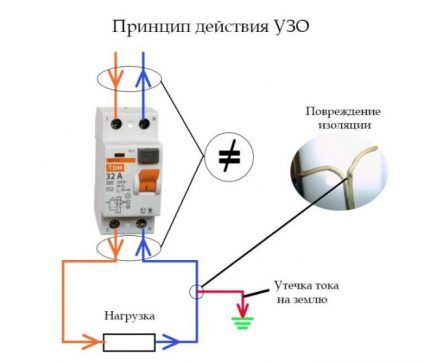
The task of the fire protection RCD is to control this situation and prevent overheating of the wiring. If the insulation is damaged and a leakage current has formed, the protective device simply disconnects the problem line from the network. If there is a differential switch in the circuit, the metal cores heat up too much and a fire does not even occur.
The leakage current in the range of 300–500 mA and a voltage of 220 V is the heat generated, equal to the heat generated from a lit household lighter. Such heat generation inevitably leads to ignition of the wiring and everything nearby.
The main function of the class of RCD under consideration is not human protection, but increased fire safety. To prevent electric shock, conventional devices with a lower leakage current rating are placed in the circuit after fire protection devices.
Functionally, the fire protection RCD protects:
- Input cable in front of you.
- Wiring the consumer line after yourself.
- Connected electrical equipment, when the standard one located below does not operate in the event of a fault differential switch.
The fire protection RCD is part of the cascade protection of the 220 V electrical network. It is not used in smoke and fire monitoring systems.On the contrary, such protective devices should not be present in them. Under certain circumstances, they can disable such a control system, which is completely unacceptable.
Equipment selection criteria
Existing RCD are divided into single-phase and three-phase. Only the first devices are used in everyday life. A single-phase line almost always goes to an apartment or a private house from the electrical panel. For this purpose, a differential switch is used with two terminals (input plus output), whereas three-phase analogues have four terminals for wires.
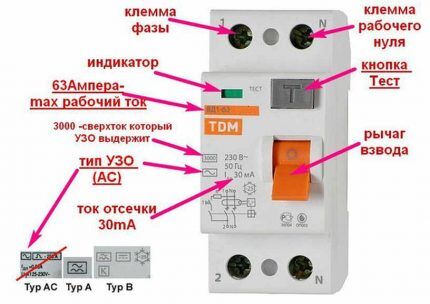
Residual current devices are:
- electronic;
- electromechanical.
The former are more expensive, but less reliable. In almost all cases, it is best to take a fire protection RCD of the electromechanical class. This switch does not require external power. If the supply line breaks, the electronic analog stops working and monitors for insulation damage. Plus, during a power surge, its response time increases.
The two main criteria for choosing a fire RCD are the selectivity of the device (the ability to set a shutdown delay) and the high leakage current parameter (100–300 mA). If one of these conditions is not met, then the system of protective devices in the electrical panel will not work as expected.
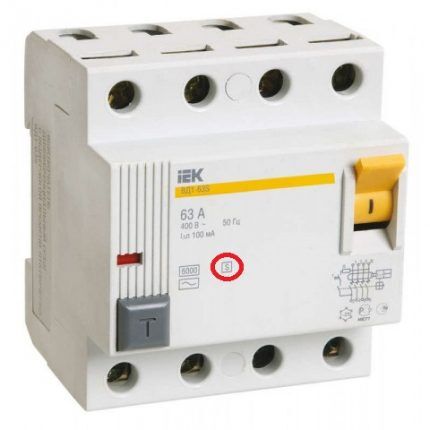
According to the standards, a fire protection RCD must differ at least three times in a larger direction from the downstream conventional one in:
- leakage current;
- response time.
If the difference in these parameters is less than three times, then when the downstream differential switch is triggered, the fire protection device will also react to disconnect the circuit. As a result, it will be more difficult to find out the cause of the shutdown, and all consumers in parallel lines that have no problems will be left without power.
Ideally, a cascade circuit of various RCDs should work so that when problems arise, only the device that is located closest to the location of the insulation breakdown reacts. In this situation, only the protected circuit is switched off. The rest remain under tension.
With the requirement of a high leakage current parameter, the situation is as follows. For conventional RCDs it is selected within the range of 10–40 milliamps. The operating electric current (maximum consumption by electrical appliances connected to the line) in this case reaches 16–40 A. For lighting and sockets with household appliances, this is quite enough.
However, in any electrical network there are natural leaks. In the project of an intra-apartment or intra-house energy system, they are specially calculated in order to correctly select the RCD. They should not exceed 1/3 of the leakage current of the selected differential switch for a particular line. Otherwise, the protective device will trigger falsely on a regular basis.
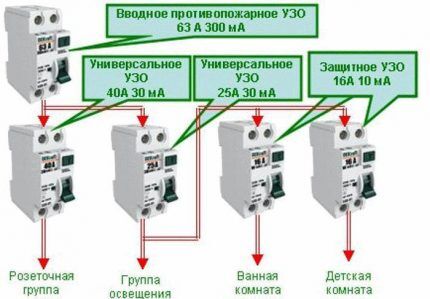
If the protective device is selected, as for the usual case, at 10–40 mA, then the power supply will be permanently disconnected. In fact, the RCD will continuously detect leaks, triggering a power shutdown in all power supply lines of the house.
Safety switch installation diagrams
The RCD is not designed to monitor overloads in the electrical network, so it must be installed together with a standard “automatic” - circuit breaker. This way the protection will be complete in all problematic areas.
The standard diagram for connecting protective devices in an electrical panel is as follows:
- The first machine at the entrance is a machine.
- Then put electricity meter.
- Then a fire protection RCD is connected (100–300 mA).
- Afterwards, the circuit is divided into several separate consumption lines with an RCD against electric shock (10–40 mA).
In some circuits, the first circuit breaker is changed to packet switch, and less powerful machines are then installed on consumer lines. This option also does not contradict the rules.
When connecting wires, it is important to ensure that the outputs from the RCD are not combined at a common zero and do not intersect anywhere with other neutral conductors or the panel body. After this protective device, the line should immediately go to another RCD or circuit breaker, and then directly to consumers.
After installation is completed, it is necessary to check the correct assembly of the entire circuit and the functionality of the protective device.
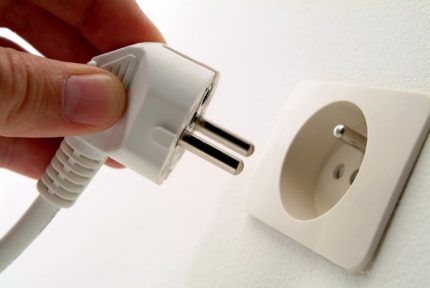
Then the differential switch itself is checked. To do this, most RCDs have a “T” (“TEST”) button. When it is pressed, the calculated leakage current is simulated, as a result of which the protection should operate normally.Moreover, testing should work regardless of whether there is a load or not.
If when you press “TEST” the RCD does not disconnect the line, then it is faulty. It is possible that the leakage simulation circuit is broken. In this case, the protection device will continue to perform its functions as intended. However, even such a switch is better to be replaced immediately. It is recommended to carry out such a check once a month.
Conclusions and useful video on the topic
It is necessary to clearly separate the functions with the parameters of fire-fighting and conventional RCDs. These devices look and feel exactly the same on the inside. However, the tasks assigned to them are different. To understand all the nuances of these differences, we recommend additionally watching the videos below.
Purpose of fire protection RCD:
What is a residual current device with a description of ratings and types:
Why connect household appliances through an RCD:
You can always install a fire protection RCD yourself, since the instructions are simple and understandable even for an amateur. It has only two inputs, you only need to connect a couple of wires. It is only important to correctly select the ratings of this device so that it works when needed. But if you don’t have the skills to make such a connection, it’s better to invite an electrician.
Do you have experience in installing fire protection RCDs yourself? Share your accumulated knowledge with visitors to our site, and also ask questions on the topic of the article in the block below.



